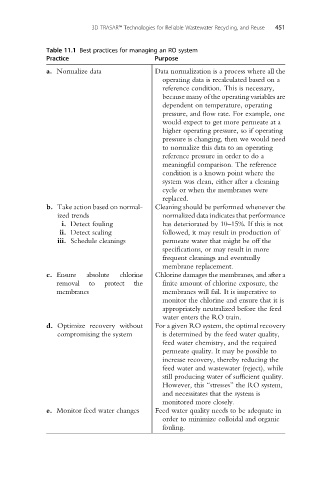Page 481 - Industrial Wastewater Treatment, Recycling and Reuse
P. 481
3D TRASAR™ Technologies for Reliable Wastewater Recycling, and Reuse 451
Table 11.1 Best practices for managing an RO system
Practice Purpose
a. Normalize data Data normalization is a process where all the
operating data is recalculated based on a
reference condition. This is necessary,
because many of the operating variables are
dependent on temperature, operating
pressure, and flow rate. For example, one
would expect to get more permeate at a
higher operating pressure, so if operating
pressure is changing, then we would need
to normalize this data to an operating
reference pressure in order to do a
meaningful comparison. The reference
condition is a known point where the
system was clean, either after a cleaning
cycle or when the membranes were
replaced.
b. Take action based on normal- Cleaning should be performed whenever the
ized trends normalized data indicates that performance
i. Detect fouling has deteriorated by 10–15%. If this is not
ii. Detect scaling followed, it may result in production of
iii. Schedule cleanings permeate water that might be off the
specifications, or may result in more
frequent cleanings and eventually
membrane replacement.
c. Ensure absolute chlorine Chlorine damages the membranes, and after a
removal to protect the finite amount of chlorine exposure, the
membranes membranes will fail. It is imperative to
monitor the chlorine and ensure that it is
appropriately neutralized before the feed
water enters the RO train.
d. Optimize recovery without For a given RO system, the optimal recovery
compromising the system is determined by the feed water quality,
feed water chemistry, and the required
permeate quality. It may be possible to
increase recovery, thereby reducing the
feed water and wastewater (reject), while
still producing water of sufficient quality.
However, this “stresses” the RO system,
and necessitates that the system is
monitored more closely.
e. Monitor feed water changes Feed water quality needs to be adequate in
order to minimize colloidal and organic
fouling.

